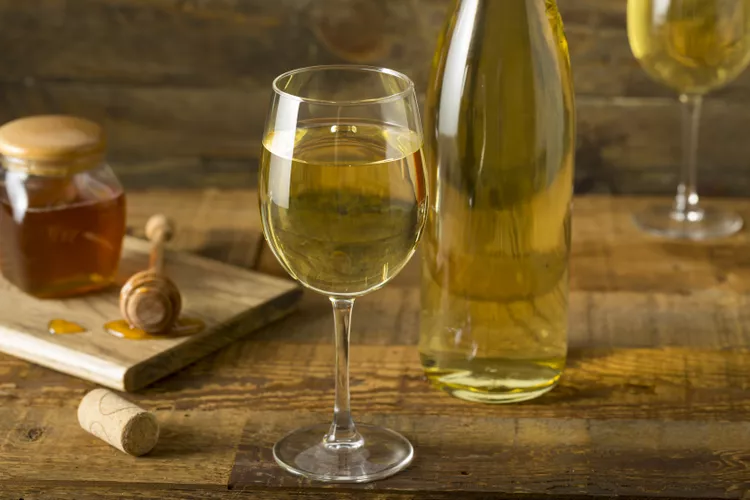Often referred to as honey wine, mead doesn’t actually fit into the categories of wine, beer, or liquor—it's in a league of its own. This fermented drink is steeped in history, potentially one of the oldest alcoholic beverages of all time. But what exactly is mead, or honey wine? Are there any nutritional benefits or sustainable perks that come with opting for this boozy beverage over other happy hour favorites? Here's a full breakdown.
What Is Honey Wine?
While there are certainly wines with added honey that could technically be called "honey wines," that’s not what we’re talking about here. Mead is called honey wine by some, though that's technically a misnomer, as it's far different from what we typically consider to be wine. It's made by using a fermentation process just like any other alcoholic beverage—but instead of grains or grapes, it’s honey that is undergoing fermentation in this popular brew. In fact, there are specific criteria outlining how much of the concoction must be fermented honey in order for the final product to be considered mead. Water and yeast round out this very simple, three-ingredient recipe.
While you may think this beverage would taste sweet, the flavor profile really depends on the variety of honey used, any additional ingredients, and fermentation time. Mead can range anywhere from sweet to dry, and still to sparkling. Herbs, fruit, hops, grains, and spices might be added in to change the concoction's flavor, plus its health benefits. Countless spinoff recipes exist, each with their own unique names—from T’ej, an Ethiopian gesho root-infused mead, to the medieval Braggot, which is honey malted barley brew, or a mashup of mead and beer.
This drink can have an alcohol by volume (ABV) percentage of anywhere between four and 20%, depending on how long it has been fermented. The longer the fermentation time, the drier the mead, and the higher the alcohol content—this way, the yeast has more time to consume the sugar found in the honey before converting it to booze.
In terms of history, mead predates both wine and beer. It can actually be traced back thousands of years (between 20,000 and 40,000 years ago to be exact), when people would drink the naturally fermented liquid left behind by honeybees. It has also been referenced in ancient Greek history as a gift from Aphrodite, earning it one of its nicknames as the “nectar of the gods.” Plus, it has been said to be the celebratory libation of Nordic Vikings—and even pirates.
The medieval English would infuse mead with herbs to alleviate a whole host of ailments. In fact, it was during these times that the term “honeymoon” came to be, as it was tradition for a newlywed couple to drink this honey beverage during a full moon cycle as a way to boost fertility.
Nutritional Benefits of Mead
While this golden nectar was utilized medicinally in ancient history, are there actual health benefits associated with it?
Generally, most meads are not heated beyond 110 degrees Fahrenheit. This means that the therapeutic benefits of the honey it contains stay intact. This is because raw honey is chock-full of heat-sensitive bioactive plant compounds that result in potent anti-inflammatory, antibacterial, and antioxidant benefits. It is also well known to speed up wound healing, soften seasonal allergy symptoms, and even treat or prevent coughs.
Despite the fermentation process used to create mead, evidence isn’t yet robust enough to support the drink as a source of probiotics. However, honey is an excellent prebiotic. Prebiotics feed our healthy bacteria in the gut microbiome, helping this microorganism community to support not only digestion but immune health as well. Mead’s prebiotic content also lowers its glycemic index, or its effect on our blood sugar, resulting in a less intense sugar spike after you enjoy it. This is beneficial not only for those with metabolic concerns, but also for those of us who want to avoid energy spikes and crashes.
That being said, mead does contain alcohol, a known inflammatory agent, especially in the microbiome and gastrointestinal tract. So unfortunately, the more you drink, the less gut health benefits you’ll be gaining.
The fruits, herbs, and spices that are sometimes infused into this honey-rich beverage will also have a variety of health perks depending on the type. This is thanks to the multitude of micronutrients like vitamins, minerals, and plant compounds they may contain.
Environmental Perks of Mead
When it comes to the environment, mead can have a lasting impact as well. This is mainly due to how this ancient beverage encourages the beekeeping industry's preservation. In a world where bees are dying off at alarming rates due to climate change, deforestation, and chemical-heavy agricultural practices, opting for mead is just one more small way to stand up for the environment.
Mead production promotes the preservation of natural landscapes that pollinators utilize to create honey and keep plant species growing. These plants are not limited to flowers, but also include trees, shrubs, and many others found in a variety of different landscapes. Plus, mead doesn’t require massive fields of grain for its production (like beer, for example), helping us to reduce our reliance on these monocropping ways.
Enjoying Mead at Home
There are so many amazing companies producing mead on both a local and national level. And once you have your hands on this timeless pick-me-up, you can enjoy it simply as is after a long day at work or blend it with other flavors for smartly crafted cocktails—from sours to spritzers. Seeking out locally sourced meads is also an intentional way to promote both the local economy and beekeeping in your community.




















